The condition of the company’s well-being depends on how well management handles operating costs. Operating costs are a tool that the company can use to compete with other companies. But, of course, the company wants to make as much money as possible. So, the management will try to minimize operating expenses. But they must also pay attention to other things, so the company doesn’t fall behind. It’s easier to do this with help from other sources, like an accounting program.
Finding the balance point is a tough management task. Because the truth is that companies can’t live without operating costs. But some companies have been able to lower their operating costs to gain a competitive edge and make more money. But cutting operating costs can also hurt other things, like the quality and reliability of operations. Finding the right balance can be hard, but it can be very rewarding when you do. Accounting Software can help you in more ways than you might think. Click here to find out the pricing scheme of the system, and read the article to the end to learn more about how to deal with operating costs.
Also read: Accounting Software Implementation to Improve Your Business

The Definition of Operating Expenses
You can think of operating costs like the gas or electricity that powers a car. The company’s day-to-day operations rely on a healthy bottom line, so keeping operating costs low is crucial. Operating costs are the ongoing costs that a company must pay to run its day-to-day operations. Rent, machinery, inventory, advertising, salaries, and insurance are all components of a company’s operating costs. As a result, business owners should also allocate resources toward research and development.
A company’s primary functions or sources of revenue should be determined before estimating its operating costs. It is very important to note that operating activities differ greatly among industries. The same enterprise action may be categorized as financial or investment in one sector but operational in another. In many fields, the purchase of a building is seen as an investment opportunity. However, it’s an operational activity for a real estate corporation since the buildings are for sale.
Examples of Operating Expenses

After understanding the definition of operating expenses, you need to see an example. Here is an example of operating expenses from an American retail company Target. In the picture, there are clear records from year to year, so you can easily compare them. Consolidated statements of operations are part of the company’s cash flow statement. It would be easy to create a statement of operating expenses. However, suppose you are a large company that requires complex data management. In that case, the move to Accounting Software is commendable for the stability of your business flow.
HashMicro’s Accounting System helps you to improve the accuracy of money calculation because the system can monitor the overall financial condition. So, you can know in-depth analysis and accurate forecasts of your income. Because finance is a broad and detailed discussion, it needs more attention, especially help from the system. If you look further, the example of operating expenses is divided into two, namely office-related and compensation-related.
Office-related
Now, you are already familiar with the various operating costs included in the Target retail company’s operating costs. However, you should also be aware of the general operating costs of various companies. Although the companies are unique, some operating costs are shared by both of them. The following is a list of the operating expenses that an office typically spends:
- Accounting expenditures
- Depreciation of fixed assets assigned to non-production areas
- Insurance costs
- Legal fees
- Office Supplies
- Property taxes
- Rent costs for non-production facilities
- Repair costs for non-production facilities
- Utility costs
The above costs are expected and are often considered when planning the following year’s budget. Then the budget plan will be easier for the accounting staff to make. In addition, some operational costs occur regardless of the type of business, such as payroll and marketing. In contrast, others are specific to certain industries and businesses. However, the level of these expenses may vary based on the size or industry of the company.
Also read: EVA HRIS Essentials as The Best Online Payroll Problem Solution
Compensation-related
Compensation costs and sales and marketing costs are two of the most common operating costs. Paying employees is a big part of what it costs to run a business. It can be anything from wages and salaries to commissions, contributions to a retirement plan, and benefits. Accounting-wise, pay, and benefits for production staff and direct labor can also be put in the same category as operating costs.
Companies think that by increasing their operating budget at the end of the year, they can get the extra money they need for the next year. The best way to list these costs is in a separate section, not under the general heading of ‘operating expenses.’ Even though this is still how many businesses run. Postage, phone bills, and general office supplies that all departments use are usually not included in operating costs. Instead, these common costs are called administrative costs.
How to Calculate Operating Expenses

Most of the costs that make up operating expenses remain the same, which means they are not directly related to revenue. Instead, these costs remain the same no matter how much is generated. Note that not all costs in a business are like that. For example, office supplies are a variable cost because you need to buy a lot of them if you want production to increase. So, operating costs are calculated by adding up all costs. Some of the costs are business operations, such as accounting, payroll, insurance, marketing, repairs, utilities, insurance, and other costs.
Conclusion
Companies need to find the balance point of their operating costs to determine how well they manage their costs and stock. If OpEx as a percentage is higher than its competitors, it shows that the company is less efficient. The reason is that the company needs to manage its finances better. Then, what if the company has a Financial System that can automatically organize all of its financial tasks? There is no doubt that the company can maximize profits and make precise budget plans.
HashMicro’s Accounting System is a full-fledged software with robust features. All the features and modules in the system support you in making the best financial decisions. Features like journal entries and reconciliation can be used to keep track of cash flow. In the system, you can compare OpEx, which is one way to show how well a company is doing. Because the system can automate tasks, it will be easier for you to handle OpEx in the future. Get a free demo on our website, now!














